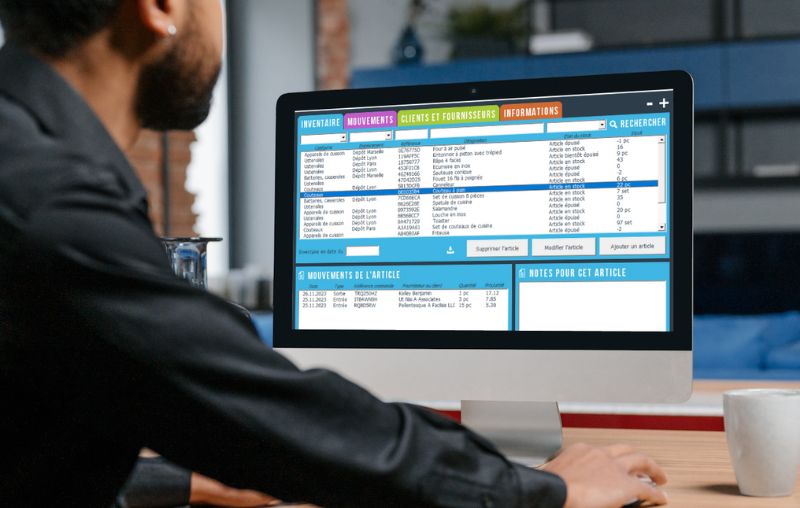Retailers : best practices for managing your inventory
Having products in stock to respond quickly to customer needs is essential when you own a business. From the assessment of stock levels to the use of inventory management technologies, several aspects need to be optimized to ensure maximum efficiency and profitability.
Categorize your products
One of the first steps in managing your inventory is to classify your products by category. This makes it easier to find items and improve replenishment to better anticipate sales trends. But how do you go about it?
It's essential to start by sorting all your products according to value, use, sales volume or seasonality: for example, in a clothing store, you might divide your items by season and sales volume. Best-selling products need to be identified so that you can meticulously monitor their stock levels to ensure you never run out.
Once you've established your categories, organize them in your storage space. You can place the most popular products in easily accessible locations to minimize search time, and seasonal furnishings in less reachable locations.

Anticipating out-of-stock situations
Nothing is more disappointing for a customer than to discover that a product they need is out of stock. To avoid this disappointment, it's important to anticipate potential stock-outs.
To do this, analyze your sales and purchasing statistics. Based on past sales, first identify the best-selling products with the highest turnover. These are your priority products, as they often represent the majority of your sales. You need to plan regular replenishment of this category. For example, suppose you're a wine merchant and your best-sellers are red wines under €10. In this case, analyze the number of references sold each month over the past year and link this to your suppliers' replenishment lead times. Order a volume representing several weeks or months of sales to anticipate unforeseen events and longer delivery times.
Above all, it's important to establish a solid relationship with your suppliers : by communicating regularly with them and sharing demand forecasts, you can work together to anticipate replenishment needs and avoid delays in product delivery.

Carry out inventories on a regular basis
Inventories enable us to maintain a precise, up-to-date overview of the quantity of each product in stock. But why is this so important ?
Regular stocktaking keeps your data up to date: it avoids ordering errors due to out-of-date information, minimizing the risk of product surpluses or shortages. Regular inventories also enable you to quickly detect any discrepancies between theoretical data and actual physical stock levels: you can then identify problems such as theft, data entry errors or damage, and take corrective action to avoid financial loss. Also, by analyzing inventory results, you can better anticipate fluctuations in demand and adjust your procurement strategies accordingly. This enables you to maintain optimum stock levels, avoiding the costs associated with excessive storage or stock-outs.

Optimize your storage space
To organize your storage space, you can set it up according to frequency of use or product category. As mentioned above, place popular or best-selling items within easy reach for quick accessibility, while seasonal or slower-moving products can be placed in less accessible areas of your storage space. Prioritize the vertical space available in your warehouse or store with shelving : this can free up floor space for other activities. This can be particularly useful in tight spaces where every square metre counts.
To improve your storage area, identify each category with labels to facilitate restocking and regular inventories. You can use color codes if necessary, or posters to make it easier to identify products quickly.
Use software to manage your inventory
Even for small businesses, inventory management can quickly become a real headache and a source of errors. Fortunately, a variety of inventory management software packages are available on the market to help you with this task.
You can start by organizing your inventory by part number, making it easier to navigate. Simple solutions such as Excel spreadsheets can be used to sort and organize your information efficiently. However, for more comprehensive, real-time management, investing in dedicated software can be a wise decision that will save you time on manual stock tracking.
Among the multitude of inventory management software packages on offer, there are several criteria you need to take into account to ensure that it meets your specific needs. Make sure it offers a real-time inventory solution, as well as a user-friendly interface for easy use by all members of your team. Software such as Yokitup (specialized for catering), or Odoo offer a complete solution for improving your company's performance. By investing in these tools, you can increase productivity, reduce errors and make informed decisions to grow your business.

Effective inventory management is becoming a fundamental pillar of any successful business. With well thought-out inventory management, your business will be positioned for growth in an ever-changing competitive environment, and you'll deliver a satisfying experience to your customers.
















